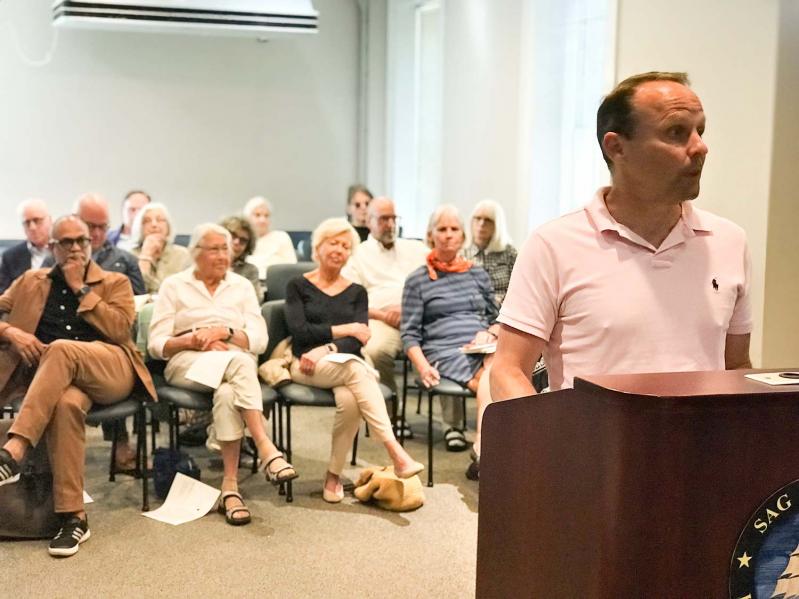A public hearing last week on Adam Potter’s planned development of a 64,429-square-foot, mixed-use building on Bridge Street in Sag Harbor Village brought out many critics.
John Shaka, the planning board chairman, called the “public scoping session” an “early step” in the long review process required under the New York State Environmental Quality Review Act, or SEQRA. In April, the planning board determined that the project had the potential to have a significant environmental impact on the constrained site and would require more detailed review.
Those who spoke at the June 12 public hearing were tasked with discussing items they wanted Mr. Potter to address in that environmental review. Many comments pointed to concerns over flooding, parking, traffic, contamination from incomplete environmental remediation at the location, and the incongruity, in the surrounding neighborhood, of the building, which would encompass nearly 8,000 square feet of so-called “commercial service” space and 44 apartments.
“Over all, I think it went very well,” Mr. Potter said after the meeting. “Nobody brought up anything that we’re not already addressing. The purpose was to comment on the scoping document, not to air out people’s feelings about the project.”
Nonetheless, mixed in with pointed criticisms of the project and specific requests for items to be added to the draft environmental impact statement (D.E.I.S), feelings crept into the commentary, and no one at the meeting expressed positive ones.
Jeff Bragman, an attorney speaking for Save Sag Harbor, a civic organization, kicked off the criticisms by saying the current draft scope did not explain how muck and material extracted from the site would be “dewatered,” a major concern, he said, since many “contaminants of concern” have been detected in the soil there, including cyanide. Specifics about the dewatering process, and a baseline list of contaminants trapped beneath the parcel, were necessary in the environmental review, Mr. Bragman suggested.
The lots on which Mr. Potter would like to build — numbers 5,7, and 11 Bridge Street — were previously part of a Superfund site, as designated by the federal Environmental Protection Agency, that is administered by National Grid. An environmental easement constrains the property so that the utility company can fulfill its requirements of a site management plan, negotiated with the New York State Department of Environmental Conservation. Mr. Bragman, and later Douglas Newby, a resident of the village, both said the easement prohibits the construction of housing over the toxic soil.
Mr. Potter has filed a Brownfield Cleanup Program application with the state, which would entitle him to state funds should he ultimately remediate the soil. The state Department of Environmental Conservation runs the Brownfield Program. If approved, Mr. Potter could receive tax incentives for cleaning up the parcels as part of the construction.
Mr. Bragman, along with others, also questioned the financial viability of the project. He worried the building’s managers might not find enough tenants to fill 8,000 square feet of commercial service space (designated for professional offices, real estate, service businesses, or other lower-traffic, non-retail business uses). “We don’t want to see an overbuilt building that can’t be filled,” he said. He wondered if without commercial service tenants, Mr. Potter might later try to add retail, thereby affecting the Main Street business district.
Compound flooding, the phenomenon in which stormwater runoff, storm surge, and shallow groundwater combine, was raised by Nilay Oza, an architect. “This location sits at the convergence of precisely these three conditions,” he told the board. The parcels in question have “flooded for centuries” and he showed historical maps dating to the 17th century that included a named pond, George’s Pond. A 150-acre watershed drains both storm and groundwater into the area. During storms the process is “supercharged,” Mr. Oza said, and the nearby storm drains push water out instead of take water in. At moments like that, a building in that location would be like floating a bathtub on a pond. “If you unplug the stopper, water does not go out, it goes in.”
“Give George his pond back,” he pleaded. “We need comprehensive planning to address this issue for the generational task it is.” Should Mr. Potter develop his properties in a vacuum, the rest of the village’s “backyard” would be affected, with untold consequences, he cautioned.
Neighbors of the Harbor Close Condominium complex, directly across the street, had more immediate practical concerns: The construction would likely take well over a year, with many months of heavy construction traffic on narrow and overtaxed Bridge Street. Richard O’Brien, a resident, said the need to use a piling foundation — because of the unstable sand, muck, and water under the parcel — could possibly damage nearby structures during installation and create severe noise pollution.
“All of this is predicated on affordable housing,” said Maziar Behrooz, a neighbor and an architect. “It probably doesn’t even give you enough affordable apartments to house the people who will be needed to service the building and stores.” He said an analysis of the housing impact of the project should be included in the D.E.I.S.
A few speakers asked for funding details of the project. Douglas Newby, suggesting that the D.E.I.S. “needs to explain how the developer will provide bankruptcy-proof surety,” directly tied the issue of funding to the contaminated soil below. Mr. Newby painted a dire picture in which a funding failure would leave behind a gaping, off-gassing pit: “The biggest fear about large-scale development,” he said, “has always been to open up contamination that would require expensive remediation beyond the means of the developer, who would declare bankruptcy and then the village would be left with a large toxic hole behind Main Street.”
Written comments will be accepted until 4 p.m. tomorrow. With the public hearing complete, the planning board will have 60 days to amend Mr. Potter’s draft scope of his environmental review and publish what is known as the “final scope,” setting the parameters for what Mr. Potter’s team will look at in the draft environmental impact statement, which itself will be the subject of another public hearing, likely in the autumn.




